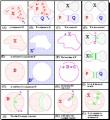
Voting, Arbitration & Fair Division: Mathematics of Social Choice
by Marcus Pivato
Publisher: Trent University 2007
Number of pages: 181
Description:
An introduction to social choice theory, which uses mathematics to study the strengths/weaknesses of voting systems, arbitration schemes, and other methods of group decision making. Lots of pictures, requires only basic linear algebra.
Download or read it online for free here:
Download link
(3MB, PDF)
Similar books
 Special Fuzzy Matrices for Social Scientists
Special Fuzzy Matrices for Social Scientistsby W. B. V. Kandasamy, F. Smarandache, K. Ilanthenral - InfoLearnQuest
This book introduces special classes of Fuzzy and Neutrosophic Matrices. These special classes of matrices are used in the construction of multi-expert special fuzzy models using FCM, FRM and FRE and their Neutrosophic analogues.
(12979 views)
 Mathematical Linguistics
Mathematical Linguisticsby Andras Kornai
The book introduces the mathematical foundations of linguistics to computer scientists, engineers, and mathematicians. The book presents linguistics as a cumulative body of knowledge from the ground up: no prior knowledge of linguistics is assumed.
(18814 views)
 Mathematics and Group Theory in Music
Mathematics and Group Theory in Musicby Athanase Papadopoulos - arXiv
The purpose of this paper is to show through particular examples how group theory is used in music. Examples are chosen from the theoretical work and from the compositions of Olivier Messiaen, one of the most influential twentieth century composers.
(9708 views)
 Math Alive
Math Aliveby Ingrid Daubechies, Shannon Hughes - Princeton University
Designed for those who haven't had college mathematics but would like to understand some applications: Cryptography; Error correction and compression; Probability and Statistics; Birth, Growth, Death and Chaos; Graph Theory; Voting and Social Choice.
(12462 views)